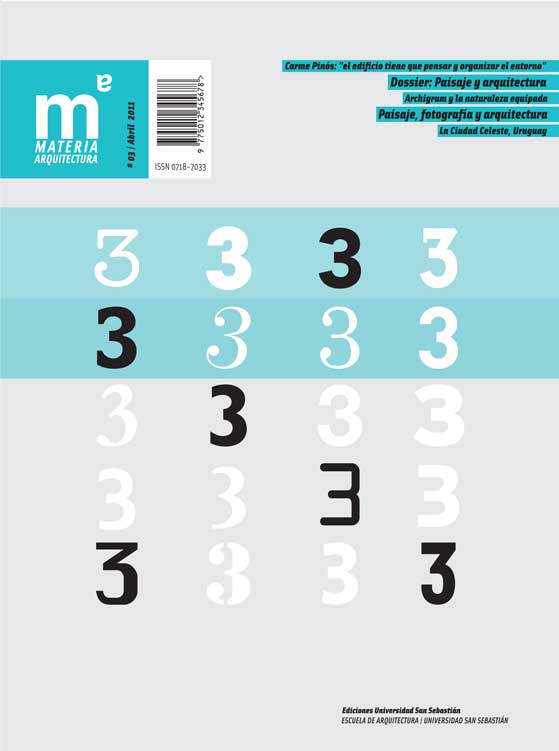La Ciudad Celeste: Paisaje y praxis urbanística en un país del Sur
Article Sidebar
Keywords:
Main Article Content
Abstract
La Ciudad Celeste es un nuevo territorio del Uruguay. Su exploración comprendió diversos escritos y talleres proyectuales. La primera parte presenta los atributos de este territorio: buena posición, dispersión y concentración de actividades y energías, transnacionalidad, dualismos sociales, diversas matrices paisajísticas, imaginarios convergentes, política fragmentaria y carácter latente. El segundo bloque trata las claves genéticas del trabajo sobre el paisaje: el “vacío” (su principal capital futuro), nombrar y bautizar el paisaje, intensificar y construir geografías, cierto “metapolitismo sui generis” y su interpretación insular. Finalmente se abren interrogantes sobre la manipulación arquitectónica del paisaje en estos países del sur: ¿práctica ilusoria, ¿cautividad en la pequeña escala, ¿sueño controlador Y se culmina anotando el cambio paradigmático contemporáneo por el cual paisajismo, arquitectura, manejo energético y gestión, se están integrando en una cultura ambiental y disciplinar más profunda.
Article Details
Materia Arquitectura provides immediate and free access to all the content of this online edition, published simultaneously with the print edition.
Materia Arquitectura does not charge authors for any concept.
All contents of this electronic edition are distributed under the Creative Commons license of "Attribución-shareAlike 4.0 Internacional" (CC-BY-SA).
The rights of the published texts and images belong to their authors, who grant Materia Arquitectura the license for their use. The management of the permits and the authorization of the publication of the images (or of any material) that contains copyright and its consequent rights of reproduction in this publication is the sole responsibility of the authors of the articles.
As long as they mention their origin, the authors are free to distribute their articles by other means. Any total or partial reproduction of the material must mention its origin.
Downloads
References
ÁBALOS, Iñaki (ed.). Naturaleza y artificio (el ideal pintoresco en la arquitectura y el paisajismo contemporáneo). G. Gili, Barcelona, 2009.
ÁBALOS, Iñaki. “La Belleza Termodinámica”. CIRCO n.º 157, 2008.
ALEMÁN, Laura. “Hilos rotos… (Ideas de ciudad en el Uruguay del siglo veinte)”. Multicopiado Farq/Udelar, Montevideo, 2010 (julio).
ASCHER, François. Métapolis (ou l´avenir des villes). Jacob, Paris, 1995.
AYERRA, Fabio et al. “Fábrica de Paisaje (Nuevas definiciones para el accionar en la costa sur del Uruguay)”. MAPEO n.º 3, Taller Danza, Facultad de Arquitectura, U. De la República, Montevideo, 2007.
CAPANDEGUY, Diego. “El encanto de la medianía: Uruguay y sus arquitecturas recientes”. En: OTERO, Rubén, et al. (cur.), 2010.
CAPANDEGUY, Diego. “Panorama de la Arquitectura Uruguaya”. Gob. de San Pablo / Museu Da Casa Brasileira, San Pablo, 2009.
CARERI, Francesco. Walkscapes. El andar como práctica estética. G. Gili, Barcelona, 2002, p. 108.
CORBIN, Alain. Le Territoire du vide (l`Occident et le decir de rivage, 1750-1840). Aubier, Paris, 1988.
DANZA, Marcelo (cur.). “LUP at The Venice Biennale (XI International Exhibition of Architecture)”. Montevideo, Farq /Udelar /Mec, 2008.
DÍAZ MORENO, Cristina y GARCÍA GRINDA, Efrén. “Atmósfera, material del jardinero digital”. En: ÁBALOS, Iñaki. (ed.), ob. cit. 2009.
ECO, Umberto. Historia de la fealdad. Lumen, Barcelona, 2007, pp. 8-20.
GAUSA, Manuel, et al. Diccionario Metápolis de la Arquitectura Avanzada. Actar, Barcelona, 2001.
GAUSA, Manuel. Barcelona metápolis (Met 1.0). Actar, Barcelona, 1999.
HERREROS, Juan. “Geografía infraestructural: técnica proyectual y diversión”.
En: HERREROS, Juan. (dir). Cambio + Energía + Información (Palacios de la Diversión. Isla de San Miguel). Etsam / Depto. de Proyectos Arquitectónicos, Madrid, 2003/2004, pp. 1-2.
IACC Metápolis. Hicat. hiperCatalunya: Territorios de investigación. Metápolis / Iaac / Actar, Barcelona, 2003.
KOOLHAAS, Rem y MAU, Bruce. S.M.L.XL. Monacelli, Nueva York, 1995.
MOSTAFAVI, Mohsen y DOHERTY, Gareth (eds). Ecological Urbanism. Harvard / Mu?ller, Cambridge (MA), 2010.
MVOTMA et al. “Plan de Ordenamiento Territorial y Desarrollo Turístico de Punta del Diablo”. Resumen Ejecutivo, Montevideo, Mintur, 2000.
OSWALT, Philipp (ed). Shrinking Cities. Hatje Cantz, Ostfildern-Ruit, 2006.
PERRAULT, Dominique. With; Dominique Perrault Arquitecto. Actar, Barcelona, 1999, pp. 292-95.
SLOTERDIJK, Peter. Esferas III (Espumas. Esferología Plural). Siruela, Madrid, 2006, p. 376.
SPRECHMANN, Thomas y CAPANDEGUY, Diego. “Villa La Angostura (y la intensificación del paisaje)”. ELARQA n.º 41, 2002 (abril), pp. 4-11.
SPRECHMANN, Thomas y CAPANDEGUY, Diego. “Patagonia Jardín Global: Urbanismo en el mítico fin del mundo”. ELARQA Mx n.º 50, C. de México, 2005, pp. 28-47.
SPRECHMANN, Thomas y CAPANDEGUY, Diego. “Las Ciudades Celestes (Nuevas territorialidades en las sociedades del paisaje)”. MAPEO n.º 2, Taller Danza, Facultad de Arquitectura, U. de la República, Montevideo, 2007.
SPRECHMANN, Thomas; CAPANDEGUY, Diego y AGUIAR César (eds.). La Ciudad Celeste: un nuevo territorio para el Uruguay del siglo XXI. Farq /Udelar /Fundación Colonia del Sacramento, Montevideo, 2006.
SPRECHMANN, Thomas; CAPANDEGUY, Diego y GASTAMBIDE, Federico. “Insularidades Urbanísticas. Una invitación al Microurbanismo”. Multicopiado Taller Danza / Farq/Udelar, Montevideo, 2008 (marzo).
ZAERA POLO, Alejandro. “OMA 1986–1991. Notas para un levantamiento topográfico”. EL CROQUIS n.º 53, Madrid, 1992 (febrero-marzo), pp.32-51.
